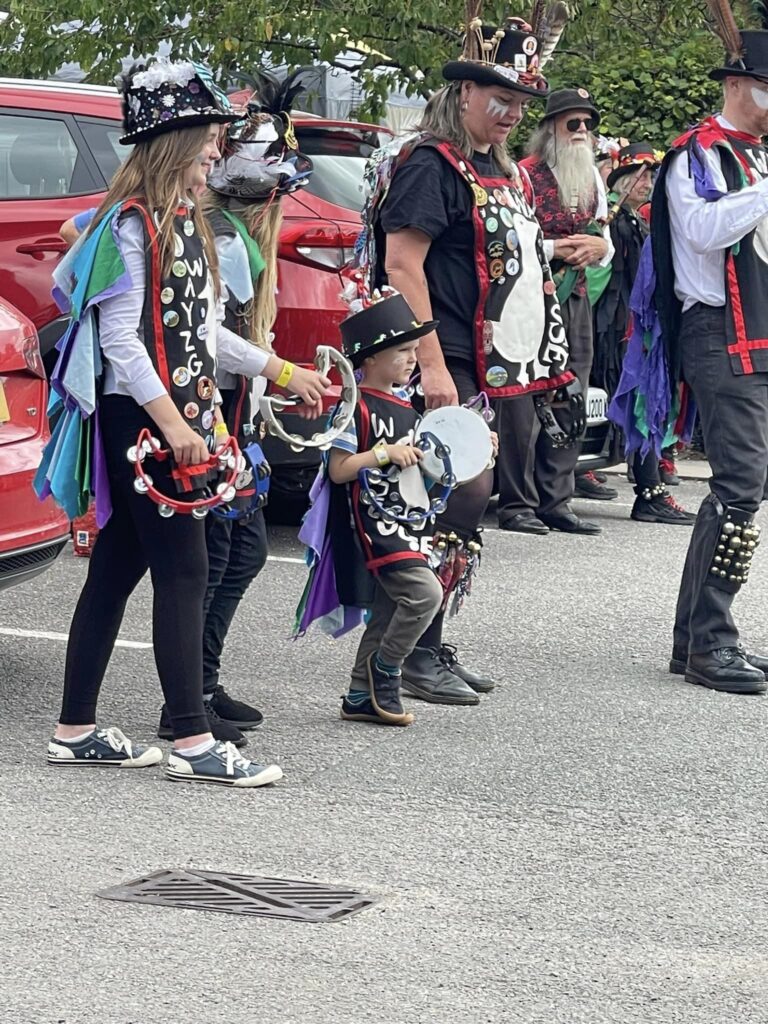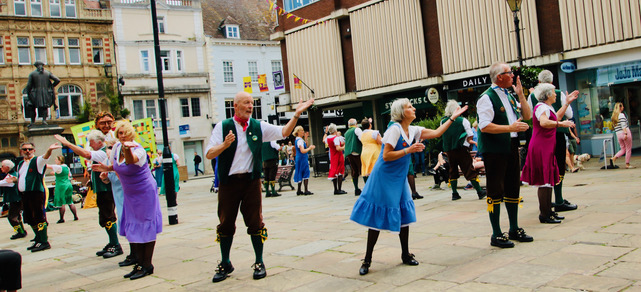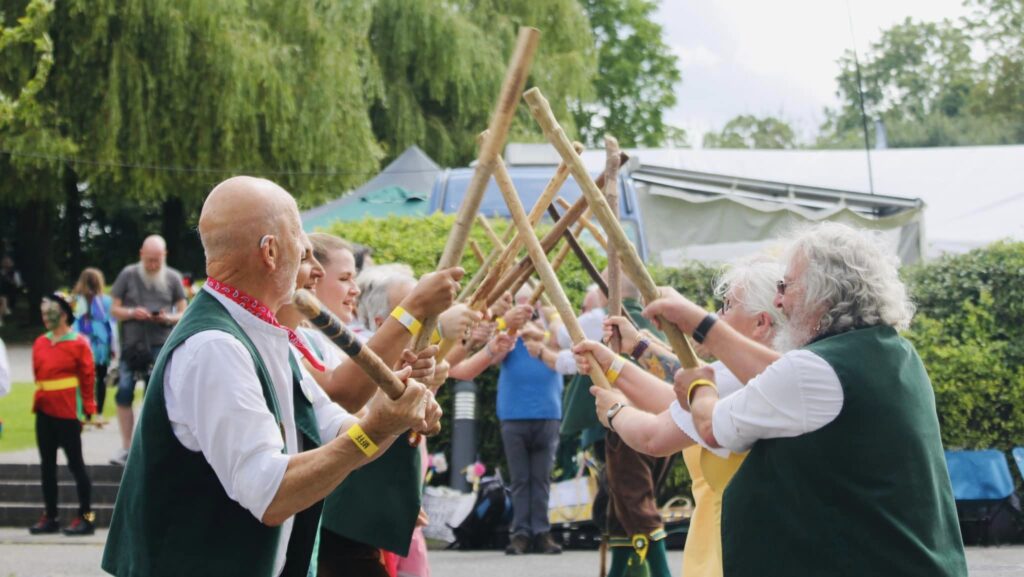
JULIA LEE BARCLAY-MORTON – YOGA, WATER AND REWRITING AUTISM
I interviewed writer Julia Lee Barclay-Morton about her experience of autism. Julia began as an experimental dramatist in New York, moving to the UK to


I interviewed Ray & Bev Langton, team leaders and founder members of Shrewsbury Morris, where people “Dance, Laugh, Have Fun, Repeat.” Bev & Ray talk about ‘distanced dancing’, the changing roles of men and women, plus the history and importance today of Morris Dancing.
Leslie: How did you personally discover Morris Dancing? What sides of yourself did it appeal to?
Bev & Ray: We discovered Morris dancing just over 50 years ago when we lived in Sussex. In our early 20’s we were already keen on folk song and music and were frequenting local folk clubs. This led us into both Morris dancing and barn dances – and I suppose we have never looked back since then.
Lots of things appealed to us including the music, which is very hard to sit still to! We both discovered a love of dancing and also the camaraderie and friendship that comes with a group of like-minded people.
Leslie: Tell us what I would see and hear if I was a spectator at your ‘distanced dancing suite’. How do you put together these routines?
Bev & Ray: Whenever you see and watch Morris dancers the signature sounds are the bells. Shrewsbury Morris, like many others, found themselves bereft of their regular dancing during lock-down time. Regular practices and dance outs were substituted with Zoom, dancing around the kitchen, on-line ceilidhs, newsletters, competitions and many other things too. However, nothing really replaced coming together to dance. As lock-down restrictions started to ease we looked at ways of coming back together. There was no national guidance for Morris dancers but we started to look at what was possible for sports clubs, exercise classes etc. We desperately wanted to come together to dance but equally did not want to risk people’s health or doing anything foolish. As it became possible to meet in small groups we looked at our dances and realized how many of them involved quite close contact. So we set too and devised some dances, some original and some adaptations, that meant we could dance but meet social distancing rules. So extra long sticks, no hands-around, wide sweeping moves and to make everything easier to manage we disbanded separate men’s and women’s dances and danced in mixed groups. Just for a bit of fun we decided to give this group of dances the rather grand name of our ‘Distanced Dancing Suite’!

As time went on we were able to return to our original repertoire but decided that we actually liked some of these mixed dances. So we now dance as The Shrewsbury Lasses, The Shrewsbury Bull & Pump Morris Men and in mixed sets as Shrewsbury Morris.
Since our very early days we have been writing dances for the team. Ideas come from traditional figures, tunes that ‘talk’ to us, patterns and shapes around us, and a whole mixture of thoughts and ideas. The tune dictates the stepping and sometimes the moves too. Sometimes new dances are completed before the team try them, but other times there are some vague ideas which are then worked up. Both the men and the women also dance some traditional dances and along some dances that have been taught to us by other teams.
Leslie: What’s distinctive about The Bull & Pump Morris Men? What are the sources of their repertoire and how do they adapt the traditional moves to their performances (assuming they do produce their own versions)?
Bev & Ray: Most teams around the country have their own identity. Bull & Pump’s kit is quite unusual with their green waistcoats and brown breeches – they say that the colour of their kit reflects the rural nature of the county we live in!!!!
A lot of teams dance stick dances but Bull & Pump certainly hit their sticks with a little more vigour than some sides – or are they just play-acting?
Some of the dances are traditional Cotswold dances – usually danced in a set of six men either with sticks or hankies. Others are self-penned and have some unusual names such as The Vortex, Pieces of Eight and most recently The Wriggly Worm. There is often (but not always) some connection between the name and the figures in the dance.

Leslie: Tell us about ‘Shrewsbury Flourish’ – what’s different about the ways these dances are put together and performed?
Bev & Ray: Back in 1981 The Shrewsbury Lasses were invited to the prestigious Sidmouth Folk Festival. As well as dancing they were asked to run a series of workshops. At that time there was still some controversy about women dancing ‘Morris’ so the workshops were termed ‘Women’s Ritual Dance’. The team taught a different dance each day but decided to also write a brand-new dance. The idea being that this new dance could be danced by any team i.e. either men or women, in shoes or clogs or whatever their style. It had to be both simple but different and have a wide range of appeal. A set of six dancers holding a pair of short sticks with plenty of movement and pattern plus a chorus, which is called the Flourish. The dance The Shrewsbury Flourish is now danced by teams across the country from Cornwall to County Durham – although no one else dances it quite like the Shrewsbury Lasses. Only last week we saw on social media that a team in Devon had been teaching it to a local Scout group.
Leslie: Tell us about Shrewsbury Clog. What sights, sounds and moves would a typical performance involve?
Bev & Ray: Shrewsbury Clog is open to any member of Shrewsbury Morris who wants to learn traditional clog dancing. Currently there are seven Cloggers. They dance in traditional wooden clogs and the dances are traditional sequences of steps that come mostly from the North of England along with North Wales. Clog dancing is similar to tap dancing although wooden soles of the clogs do not bend.
The footwork is quite intricate and the tapping of the clogs on the floor make a distinctive and often very loud noise. Clog dancing places a much greater emphasis on stepping rather than moves between a group of people.
Traditionally the place to see clog dancing would often have been in the back room of a hostelry with a floor of flagstones. It was often fast and furious dancing to a single musical instrument such as a fiddle.
Leslie: What’s the story behind the Septimus The Giant Shrewsbury Cobbler project?
Bev & Ray: Our giant Shrewsbury Cobbler was a very exciting project. Shrewsbury Morris were approached by Thingumajig Theatre, professional puppeteers from Yorkshire, to build a giant dancing puppet. From a germ of an idea we were fortunate in obtaining Arts Council England and Shrewsbury Town Council funding to develop the whole project. A story was written, a name was chosen for the cobbler and plans were put into place. Two weeks intensive work saw all of Shrewsbury Morris members work under the guidance of Thingumajig Theatre to build Septimus. His inaugural performance was accompanied by new tunes, new dances and a magnificent set of colourful flags. He is unique to Shrewsbury Morris – but only dances out on special occasions.

Leslie: What are the historical roots of Morris Dancing and the costumes/instruments used? In what ways is it a living tradition that has something to say to us today?
Bev & Ray: The origins of Morris dancing has to be one of the biggest unanswered questions. There are varying theories e.g. from the times of the Medieval games, from the Moorish traditions from Spain and other ideas too but no one really knows. There is evidence that it dates back to the 15th or 16th century times and it was often associated with rural and village festivities although there is also evidence that it could be found in Henry VIII’s court antics and entertainment.
Costumes (or kit as we call it) have varied over the years but originally for poorer people it would have included some everyday clothes with some added decoration. Dancers from the Cotswold’s traditionally wear crossed sashes across their chests called baldrics. Dancers from the North West often wear hats decorated with fresh flowers. Until squeezeboxes were invented music would have been from a fiddle or a pipe and tabor. However, in more recent times from the mid 1800s, a more popular instrument has been the melodeon – the advantage being that it is much louder than the other two mentioned. Today many teams dance to a big band of musicians.
Morris dancing is a wonderful example of a living tradition and there are now hundreds of teams across the country wearing an array of different couloured kits and dancing a mix of styles from North West Clog, Border Morris from the Welsh Borders, Molly Dancing from East Anglia along with Cotswold Morris. Many teams have now opened up to become mixed teams, some teams dance entirely self-written dances others purely traditional dances passed down through many generations. Everyone recognizes the sound of the bells and there has been definite change of attitude in people appreciating Morris dancing – although we still have a long way to go to getting official Government recognition as being part of our national heritage.
As for Ray & Bev and Shrewsbury Morris – as we always say we wear our bells with pride and are proud to take the name of our home town. Forty-eight years of Shrewsbury Morris to date – roll on fiftieth birthday party.
If you fancy giving Morris dancing a go find out more on www.shrewsburymorris.co.uk
Next week I interview artist, writer, curator and educator Sarah Chapman who led and directed The Arts Institute in Plymouth.
ABOUT LESLIE TATE’S BOOKS:

I interviewed writer Julia Lee Barclay-Morton about her experience of autism. Julia began as an experimental dramatist in New York, moving to the UK to

I interviewed Gillean McDougall from Glasgow, who edited the collaborative projects Honest Error (on Charles Rennie Mackintosh and his wife Margaret Macdonald) and Writing the

I interviewed French writer Delphine de Vigan, whose book, No et moi, won the prestigious Prix des libraires. Other books of hers have won a clutch

I interviewed Joanne Limburg whose poetry collection Feminismo was shortlisted for the Forward Prize for Best First Collection; another collection, Paraphernalia, was a Poetry Book Society Recommendation. Joanne

I interviewed Katherine Magnoli about The Adventures of KatGirl, her book about a wheelchair heroine, and Katherine’s journey from low self-esteem into authorial/radio success and
| Cookie | Duration | Description |
|---|---|---|
| cookielawinfo-checkbox-analytics | 11 months | This cookie is set by GDPR Cookie Consent plugin. The cookie is used to store the user consent for the cookies in the category "Analytics". |
| cookielawinfo-checkbox-functional | 11 months | The cookie is set by GDPR cookie consent to record the user consent for the cookies in the category "Functional". |
| cookielawinfo-checkbox-necessary | 11 months | This cookie is set by GDPR Cookie Consent plugin. The cookies is used to store the user consent for the cookies in the category "Necessary". |
| cookielawinfo-checkbox-others | 11 months | This cookie is set by GDPR Cookie Consent plugin. The cookie is used to store the user consent for the cookies in the category "Other. |
| cookielawinfo-checkbox-performance | 11 months | This cookie is set by GDPR Cookie Consent plugin. The cookie is used to store the user consent for the cookies in the category "Performance". |
| viewed_cookie_policy | 11 months | The cookie is set by the GDPR Cookie Consent plugin and is used to store whether or not user has consented to the use of cookies. It does not store any personal data. |